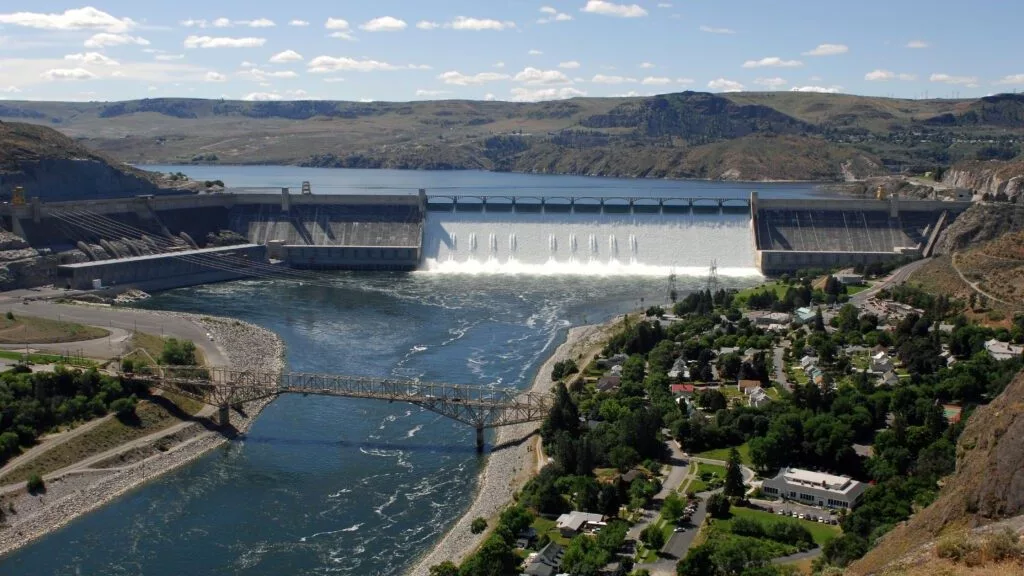GRAND COULEE, WA – Grand Coulee Dam is among the most powerful energy-generating dams on earth. It’s the bedrock of the federal Columbia River Power System — a network of 31 dams supplying more than half of the hydropower in the Northwest. Grand Coulee alone, overseen by the federal Bureau of Reclamation, generates one-quarter of that.
But critical operations at the dam are going understaffed following President Donald Trump’s orders, executed by the Office of Personnel Management, to cut probationary federal employees, freeze new hiring at federal agencies and offer incentives to get employees to retire and resign early. It’s a problem at several agencies that oversee the system, which have lost hundreds of employees and could collectively lose hundreds more by fall, and it has regional electric utilities concerned about the safety, reliability and future of the region’s power transmission.
“These are not D.C. policy-maker jobs. These are jobs on the ground, serving the people of the Pacific Northwest with clean, reliable power,” said Scott Simms, president of the Public Power Council. The nonprofit industry group represents consumer-owned utilities in six states, all of which rely on power from the Columbia River dams.
“It actually takes quite a few human beings to run these giant hydro projects on a daily basis,” Simms said. “So that is the prevailing concern in the short term: making sure that the right people are in certain jobs, and also that there’s coverage, because these are 24/7 jobs.”
Hundreds of employees gone
The Bureau is not the only player in the basin’s energy delivery system that’s suffering. The Army Corps of Engineers, which also manages the dams, could lose more than 300 employees in the next few months, according to Tom Conning, public information officer for the Corps’ Northwestern Division. Employees of the branch had until May 1 to accept a deferred resignation and be put on paid administrative leave and have until Sept. 30 to officially resign.
The Bonneville Power Administration, or BPA, which markets and delivers the dams’ hydropower across the region, has lost 200 employees, according to recent testimony from U.S. Energy Secretary Chris Wright at a May 7 House Committee on Appropriations budget hearing.
Cuts have cost the Bureau of Reclamation about 25% of its staff so far — around 1,400 people — according to reporting in Politico, and staffing levels at Grand Coulee Dam are about 70% of what they should be, according to Simms.
“We understand they were behind in being fully staffed as it was, and then the workforce reductions came into play,” he said of Grand Coulee.
Bureau officials did not respond to the Capital Chronicle’s request to either confirm or correct the figures.
“While we do not comment on personnel matters, we are committed to enhancing workforce management and are collaborating closely with the Office of Personnel Management to embrace new opportunities for optimization and innovation,” Michael Coffey, a regional public affairs officer at the Department of the Interior, said in an email.
Trump’s orders, meant to cut federal spending, have not had any impact. Analyses by the Wall Street Journal, Reuters and CBS News found the Treasury’s daily spending is up billions from the same period last year.
When it comes to BPA, staff who’ve been offered incentives to resign and retire won’t make any difference. Their salaries are not taxpayer funded, but ratepayer funded, and the agency sends a profit each year to the U.S. Treasury.
Simms said 90 more BPA jobs had been rescinded as part of the federal hiring freeze, a number confirmed by a source familiar with BPA. The agency initially lost more than 100 probationary employees under a Trump executive order in February, but has since been able to bring them back.
The 290 job losses at BPA so far account for nearly 10% of the agency’s staff, and the agency is already hundreds of employees short, according to Energy Secretary Wright’s testimony.
Hand-in-hand
All three agencies — Reclamation, Corps and BPA — collaborate to maintain and manage the Columbia River Power System.
“So they work hand-in-hand. If you don’t have reliable hydro projects, then you don’t have a stable, workable grid, right?” Simms said. “There’s craftspeople, there’s welders, there’s electricians, there’s all kinds of folks who are involved in the operation of any dam.”
The Corps is also grappling with the possibility of losing at least 325 employees in the next few months, according to Conning. That’s mostly due to resignations and early retirements.
“These reductions cut across all aspects of our operations, from senior managers, administration staff, park rangers, maintenance workers, etc.,” he said in an email. “Additionally, existing vacancies are complicating our ability to fully support various missions (like recreation).
Corps’ districts in Portland, Seattle and Walla Walla, Washington, have temporarily limited or closed some recreation areas to maintain public safety and services, he added.
Simms said the long-term concern for all of these agencies in the Northwest is not funding but having employees with the skills to preserve and improve the system. BPA and the agencies are years behind in the region as far as investing in grid expansion and connecting to new green energy projects, reporting from Oregon Public Broadcasting and ProPublica recently found.
Simms likened the predictable outcome to that of deferring maintenance on your car.
“Essentially your car is due for service and you just continue to ignore the warning light. You’re going to pay the consequences if you continue to ignore that warning light,” he said. “That is what we’re worried about in the longer term: making sure that we’ve got the right people to do the needed work. It’s not a money problem, it’s actually a people problem.”
Simms said the Public Power Council has been working with both sides of the aisle in both chambers of Congress to advocate for more investment in the region’s hydropower system and its employees.
At the May 7 Congressional budget hearing, Energy Secretary Wright said he was aware BPA’s staffing could not go lower.
“I don’t think we have room to reduce headcount there anymore,” he said. “There’ll be no more shrinkage in head count at Bonneville Power.”
Simms said federal leaders likely need to go further.
“I think we’re going to have to get our heads around the idea of probably paying incentive payments and retention payments the way we’ve seen at the FAA for air traffic controllers, the way we’ve seen it for the USDA for food inspectors, the way we’ve seen it at the Forest Service for fire mitigation personnel,” he said. “I think we’re going to be in a place where we’re going to have to use those kinds of tools to attract and retain the people that we need for these critical positions.”
Oregon Capital Chronicle is part of States Newsroom, a nonprofit news network supported by grants and a coalition of donors as a 501c(3) public charity. Oregon Capital Chronicle maintains editorial independence. Contact Editor Julia Shumway for questions: info@oregoncapitalchronicle.com.





